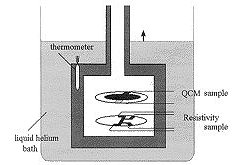
NEW SUPERCONDUCTOR PROPERTY CONFIRMED
"We...definitely link the superconducting transition to changes
in sliding friction. Something really exotic [is] going on."
- Jacqueline Krim, Professor,
Dept. of Physics, NCSU


According to Krim, "There was much initial speculation that the effect had nothing to do with superconductivity at all - that it was just a phase transition in nitrogen. There was also speculation that the effect would reveal a surface transition temperature for superconductivity that was different from the bulk transition temperature. We spent some time carefully checking out the aforementioned suggestions, and found the change in friction to be exactly tied to the bulk transition temperature."
Despite the billion-dollar industrial importance of friction, it is still poorly understood. In Krim's proposal to the National Science Foundation she states, "There appears little relation between the friction and the fraction of electrons in the superconducting state. A leading theory of superconductivity-dependent friction by Bruch predicts that the effect will be highly influenced by the polarity of the adsorbate. We propose to investigate adsorbates that are more (CO), and less (Ar) polar than N2, to determine whether they will exhibit greatly differing sliding friction effects."
A newly observed type of surface tension unique to superconducting particles was noted by a team of Southern Illinois University (SIUC) physicists in 1998. But, it is unknown if this is related to that phenomenon. As Krim puts it: "Most of the ordinary theoretical explanations appear inadequate and we are left with something really exotic going on."
 BACK to the "News" page at Superconductors.ORG
BACK to the "News" page at Superconductors.ORG